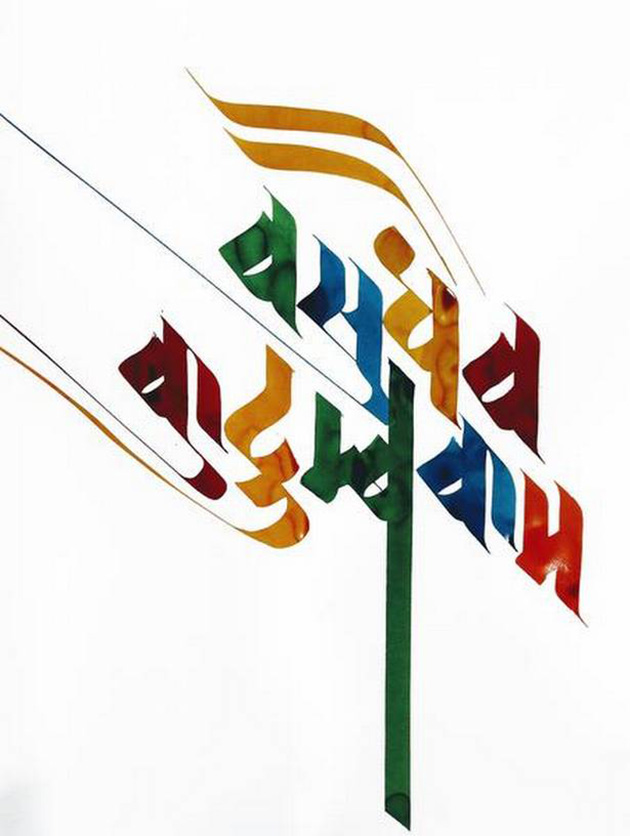Taking Devnagri to the world
At Calligraphies in Conversation, an ongoing international meet on calligraphy in San Francisco, a special focus on Indian lettering, especially Devnagri In November last year, Delhi-based calligrapher Rajeev Kumar was in California on the invitation of the Society for Calligraphy.
Just over half a year later, three more Indian calligraphers, Achyut Palav, Amol Saraf, and Gori Yusuf Husen, are in California again, this time in San Francisco; on 8th June, the organisers of a two-month-long exhibit called Calligraphies in Conversation, invited them to do demonstrations at the event’s opening ceremony, at the San Francisco Center for the Book.
Specifically, Palav will stay on to hold a special master class on the fundamentals of Devnagri script here on the evening of June 12th. In its sixth edition currently, the exhibit is an annual multicultural gathering of calligraphers. The aim, says their website, is to explore “connections between calligraphy traditions and practices from different cultures and languages through the world.”
At the opening ceremony, each artist highlighted their distinct style of practice — Husen, with traditional Islamic calligraphic art, and Palav and Saraf, both with Devnagri. Palav, who is based in Mumbai, and Saraf, who has recently moved to Florida, had both studied at the J.J. School of Applied Arts in Mumbai in the 1980s.
This heightened international interest in Indian lettering forms doesn’t surprise Kumar, whose work was displayed with Palav’s at a group show earlier this year, at the Indira Gandhi National Centre for the Arts in Delhi. “All 11 scripts of India are perfect in every way,” he says. “The Latin or Roman English script isn’t, because it’s not fully phonetic. You can’t write it properly unless you know a certain word’s specific spelling. That’s not the case with Devnagri. Also, Devnagri caters to 20 languages around the globe — Sindhi, Tibetan, Kashmiri, Gujarati, Punjabi, they’re all variations of it,” he adds.
Palav too shares similar sentiments. “I want to show people how we are rich in script,” he said before flying out. “I also want to portray my culture.” To this effect, he will show two of his works at Calligraphies in Conversation, which will be on display through August. He says these works try to visually illustrate the feeling and meaning of the phrases he’s used; this will make the literary and cultural heritage they carry accessible, and perhaps also universal.
For the first, he has chosen a line from a Marathi abhanga by Sant Tukaram. ‘Anandache dohi ananda taranga’, denotes a sense of elevated, peaceful joy that comes from experiencing life. He shows this on cartridge paper, with splashes of bright primary colours, along with light, playful Devnagri strokes in brush and steel pen. The second carries the words ‘Karma – Dharma – Yog’, also in Devnagri, but heavier and more sombre. Actions (karma) and moral choices (dharma), and their ultimate union into a sense of true self (yog), is the Indic philosophy he showcases in this frame.
In the meantime, Palav has already picked the messages he wants to carry to the 11th World Calligraphy Biennale that’s scheduled to take place in Joellabuk-du, Korea, in September this year.
The first, is ‘vaisudhaiva kutumbakam’, the Sanskrit line for ‘the world is one family’; and the second, ‘jyotine tejachi aarati’, is the Marathi phrase for ‘a flame that worships brilliance (like the sun’s)’.
“Calligraphy isn’t just about beautiful writing, it’s so much more...about emotions conveyed on paper,” Palav says. For him, words as language can only say and evoke so much. Words as art though, that’s a whole other level.
Calligraphies in Conversation: An Exhibition of Multicultural Calligraphy is on till August 30th 2019 at the San Francisco Center for the Book, California
 Taking Devnagri to the world
Taking Devnagri to the worldSource: www.thehindu.com
For the largest part ill handwriting in the world is caused by hurry.
(Lewis Carroll)



